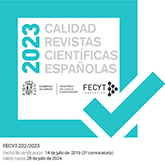A tabula lusoria found in the Republican castellum of Puig Castellar of Biosca in Lleida, Catalonia (180-120 BCE)
DOI:
https://doi.org/10.3989/aespa.094.021.04Keywords:
Roman leisure, game board, ludus latrunculorum, Roman Republican armyAbstract
We aim to show the exceptional finding of a tabula lusoria that appeared during the 2019 campaign in the Roman Republican castellum of Puig Castellar of Biosca in Lleida. The singularity of this finding lies in its location in a military fortress of the initial phase of the Roman conquest with a very precise chronology that ranges between 180 BCE and 120 BCE, and in the fact that it appeared in its original arrangement, in one of the spaces intended for the accommodation of the troops. These two elements allow us to affirm that we are facing one of the first well-dated examples of a game board in the Iberian Peninsula which provides us with clues about the activity of the soldiers in their leisure moments and tells us about the existence of Italic components among them, since board games would be an unknown pastime for the indigenous populations until that moment.
Downloads
References
Austin, R. G. (1935). "Roman Board Games II". Greece & Rome, 4.11 (feb. 1935), pp. 76-82. https://doi.org/10.1017/S0017383500003119
Bell, C. (1979). Board and Table Games from many Civilizations, vol. 1 y 2. London: Dover Publications.
Bendala Galán, M. (1973). "Tablas de juego en Itálica". Habis, 4, pp. 263-272.
Caamaño Gesto, J. M. (1984). "La cohors I Celtiberorum y su campamento de Cidadela (Sobrado dos Monxes-Coruña)". Cuadernos de Estudios Gallegos, XXXV, pp. 71-79.
Carretero Vaquero, S. (1998). "El Ludus latrunculorum, un juego de estrategia practicado por los equites del Ala Flavia II". Boletín SAA, 64, pp. 117-140.
Dasen, V. (2018). "Histoire et Archéologie de la culture ludique dans le monde gréco-romain. Qüestions Méthodologiques". Kentron, 34, pp. 23-50. https://doi.org/10.4000/kentron.2460
Dasen, V. y Schädler, U. (Coords.) (2013). "Dossier Jeux et jouets gréco-romaine". Archéothéma. Histoire et archéologie, 31 (nov.-déc. 2013).
Fittà, M. (1997). Giochi e giocattoli nell'Antichità. Milano: Leonardo Arte.
Guidi, F. (2015). Vacanze Romane. Tempo libero e vita quotidiana nell'antica Roma. Milano: Mondadori Libri.
Jiménez Cano, C. (2014). "Estudio preliminar sobre los juegos de mesa en Hispania". Antesteria, 3, pp. 125-138.
Lambrugo, C. (2015). "Giocare per terra...e per mare!". En: Lambrugo, C. y Slavazzi, F. eds., I materiali della Collezione Archeologica "Giulio Sambon" di Milano 1. Tra alea e agòn: giochi di abilità e di azzardo. Milano: All'Insegna del Giglio s.a.s., pp. 25-30.
Pace, A. (2015). "Miles ludens. Il gioco e i soldati nella Britannia romana". En: Lambrugo, C. y Slavazzi, F., eds., I materiali della Collezione Archeologica "Giulio Sambon" di Milano 1. Tra alea e agòn: giochi di abilità e di azzardo. Milano: All'Insegna del Giglio s.a.s., pp. 43-49.
Pera Isern, J., Carreras Montfort, C., Romaní Sala, N., Rodrigo Requena, E., Padrós Font, N. y de Solà Gómez, G. (2016). "El proceso de implantación territorial romana en el NE de la Provincia Citerior en el siglo II a.C.". En: Pera, J. y Vidal, J., eds., Fortificaciones y Control del Territorio en la Hispania Republicana. Zaragoza: Pórtico, pp. 167-205.
Pera Isern, J., Rodrigo Requena, E., Romaní Sala, N. y Carreras Montfort, C. (2019). "Puig Castellar de Biosca (Lleida). Una fortificación romana del siglo II a.C. en el noreste de la Hispania Citerior". Gladius, 39, pp. 19-43. https://doi.org/10.3989/gladius.2019.02
Pera Isern, J., Rodrigo Requena, E., Romaní Sala, N., Carreras Montfort, C. y Catarineu Iglesias, L. (en prensa). "El contexto cerámico del castellum republicano de Puig Castellar de Biosca (180-120 a.C.)". En: Actas del V Congreso Internacional de la Sociedad de Estudios de la cerámica antigua en Hispania celebrado en Alcalá de Henares (6-8 noviembre de 2019).
Quintana Orive, E. (2009). "D.11.5 (De aleatoribus) y C.3.43 (De aleae lusu et aleatoribus): Precedentes romanos del contrato de Juego". Anuario Jurídico y Económico Escurialense, XLII, pp. 17-37.
Richmond, J. (1994). "The Ludus Latrunculorum and Laus Pisonis 190-208". Museum Helveticum, 51.3, pp. 164-179. http://www.jstor.com/stable/24818294.
Romaní Sala, N., Rodrigo Requena, E., Pera Isern, J. y Gutiérrez Garcia-Moreno, A. (2020). "El material constructiu de la fortificació militar de s. II a.C. de Puig Castellar de Biosca (Lleida): Paviments, revestiments parietals i cobertes". En: Aquilué, X., Beltrán de Heredia, J., Caixal, À., Fierro, J. y Kirchner, H., eds., Estudis sobre ceràmica i arqueologia de l'arquitectura. Homenatge al Dr. Alberto López Mullor. Barcelona: Diputació de Barcelona, MUHBA, MAC, UAB, pp. 391-403.
Salza Prina Ricotti, E. (1995). Giochi e giocattoli. Vita e costumi dei Romani Antichi 18. Roma: Edizioni Quasar.
Schädler, U. (2001). "A forgotten Roman Game of Strategy reconstructed". Abstract Games, 7, pp. 10-11.
Schädler, U. (2013). "Games, Greek and Roman". En: Bagnall, R. G., Brodersen, K. Champion, C. B., Erskine, A. y Huebner, S. R. (Eds.). The Encyclopedia of Ancient History. London: Blackwell Publishing Ltd, pp. 2841-2844.
Published
How to Cite
Issue
Section
License
Copyright (c) 2021 Consejo Superior de Investigaciones Científicas (CSIC)

This work is licensed under a Creative Commons Attribution 4.0 International License.
© CSIC. Manuscripts published in both the printed and online versions of this Journal are the property of Consejo Superior de Investigaciones Científicas, and quoting this source is a requirement for any partial or full reproduction.All contents of this electronic edition, except where otherwise noted, are distributed under a “Creative Commons Attribution 4.0 International” (CC BY 4.0) License. You may read here the basic information and the legal text of the license. The indication of the CC BY 4.0 License must be expressly stated in this way when necessary.
Self-archiving in repositories, personal webpages or similar, of any version other than the published by the Editor, is not allowed.
Funding data
Ministerio de Economía y Competitividad
Grant numbers DGYCIT PID2019-104120GB-100-2020-2022
European Regional Development Fund
Grant numbers DGYCIT PID2019-104120GB-100-2020-2022
Generalitat de Catalunya
Grant numbers CLT009/18/00014















